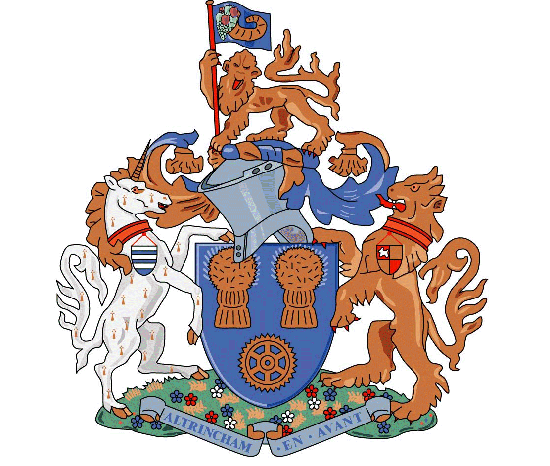ALTRINCHAM & DISTRICT AFL
LEAGUE HISTORY
‘LOOKING BACK’ By George Harrop (Founder Member)
I remember how the League was launched in the early thirties following a series of friendly games between two Sunday School teams, ‘Bowdon Church’ and Bowdon Congregational’. Although there was already the ‘Palatine League’ in the district, the late John Cook, the leader at Broadheath Congregational, called a meeting at Rigby Memorial School, Broadheath (now demolished) and eleven teams expressed their interest. These were: Altrincham Athletic, Altrincham Juniors, Altrincham Unemployed, Ashfield, Ashley O.S.A., Bowdon Corinthians, Broadheath Congregational, Hydes Ltd AFC, St Vincent’s, Timperley (St Andrew’s Lads’ Club), and last but not least, West Timperley Juniors.
Additions in 1933/34 were Altrincham Handicrafts Club, Churchill’s AFC., Altrincham Postal District Sports Club, Yeomanry AFC. and St Margaret’s. The following clubs resigned at the end of season 1932/33: Altrincham Athletic, Altrincham Juniors, Hydes Ltd., Altrincham Unemployed and Timperley (St Andrew’s Lads’ Club). It was decided therefore, to form a league comprising a hotch potch of village, church and factory clubs. The aim was to provide organized football for amateurs as cheaply, and with as few rules as possible. Bearing in mind that most of the players were still working a five and a half day week (i.e. until Saturday mid-day) and that transport was rather restricted, the League confined its boundaries to Sale, Lymm, Knutsford and Wythenshawe.
The first officials came from the two Sunday Schools – John Cook as Chairman and Harry Dawson as Secretary, with George Harrop as Treasurer. As the League expanded, George took over as Secretary and Harry became Referees’ Secretary. Mr Cook was deeply suspicious of the football hierarchy at Lancaster Gate, so at the start, the League did not affiliate with the FA. I suppose that, in a way, we were rebels. However, as the ‘Palatine League’ folded up in 1937/38 and our League extended to three divisions, it became more difficult to find enough registered referees to cover all our matches. We therefore decided to affiliate to the FA. When John Cook left for London he presented the League with the ‘Sportsmanship trophy’, which is still competed for annually. Tom Walsh (St Vincent’s representative) took over the Chairmanship at the outbreak of the 2nd World War.
In addition to the league program there are knockout competitions. The ‘Jack Pearson Cup’ for the seniors and the ‘Broadheath Central Cup’ for the reserve teams, but there have been other trophies in the past. These included the ‘Montague Burton Cup’ and the ‘Gibson Cup’ (the latter presented by the then Chairman of Manchester United, who at the time lived in Hale Barns). It is worth remembering that we only had a cash balance of Ł150, but still had four trophies to play for. There is also another trophy nowadays called the ‘Memorial Trophy’, which honours those hard working ex-secretaries, the late Ron Jepson and the late Bob Green. This trophy is presented annually to the club secretary judged by the league to have done a good job during the season.
At the beginning, the annual fee for each team was 30/- (Ł1.50), which included a deposit that was refunded if the team fulfilled all its fixtures. Each player paid 1/- (5p) to cover registration, a copy of the handbook and insurance. If a player was injured he received 3/9d (18p) for four weeks, but if the injury proved fatal, his dependents would receive Ł5. Fines for late starts, etc. were usually 1/- (5p) or 1/6d (71/2p) and the transfer fee was 1/6d (71/2p). Expenses were low enough to encourage the unemployed at the Broadheath Handicrafts Centre (an organization set up by the local council at Salisbury Road Playing Fields, Broadheath) to form a team which won the championship in 1933. Originally, league meeting were held at Rigby Memorial School, Navigation Road, Broadheath, and apart from the short break, when meetings were held in the Drill Hall, Ashley Road, Hale (the headquarters of one of out teams, The 7th Cheshire Regiment) they continued at Rigby Memorial until it was demolished and the meetings were transferred to the Broadheath Central Club, Viaduct Road, Broadheath, where they are still held to this day.
The league has been lucky in having a continuous flow of enthusiastic officials – people like Tom Walsh, John Walmsley, Ron Jepson, Jack Pearson, and Bob Green, to name just a few, not forgetting the present team including President, Harry Drinkwater. In spite of the many counter attraction, including the growth of Sunday football, the league has remained in a healthy state with three divisions. As most of the teams played on fields belonging to the council, schools or farms, it was not possible to charge for admission and for many years we were indebted to the Linotype Club for the use of their enclosed ground for our important Inter-League matches, Cup Finals, etc. Sadly this has now disappeared due to redevelopment in the area.
Speaking about the collections at such matches, they only really produced a few shillings. For example in 1935 ‘The Champions v The Rest of the League’ produced 8/- (40p) and the inter-league match against the ‘Palatine League’ raised 10/6d (52 1/2p). There have been many changes since those early days. The team sheet used to read -‘goalkeeper, two full-backs, three half-backs, and five forwards’ – no mention of sweepers or midfielders! The players’ jerseys were not numbered and certainly carried no sponsor’s names. Games had to be played in daylight; there were on floodlights available when darkness fell. It was also some time before substitutes were introduced. White painted pitch markings were a luxury, and there was more likely to be a last minute dash to get a bag of sawdust to mark the lines. Although there was the usual heckling, including ‘advice’ for the referee, crowd violence was unknown and there was a noticeable absence of foul language.
